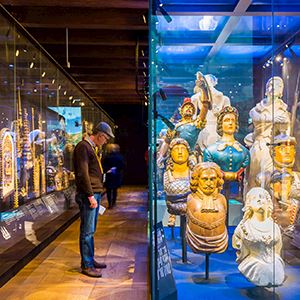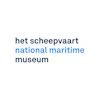
25. Oost 2, Ship's ornaments
The Greeks did it, the Romans did it and so did the Vikings: each decorating their ships with carvings, paintings and sculptures that are full of symbolism. And the Dutch did likewise. The ship’s ornaments in this room have been set up to give a good picture of the various types of decoration that could be seen on board from stem to stern. The most familiar ship’s ornament is the figurehead on the prow – the very front – of the vessel. Dutch ships often proudly displayed a lion for this purpose, but biblical, Greek or Roman mythological figures were also often used. The figurehead on warships was above all meant to scare your opponents. The ship’s name was often displayed on an escutcheon, a plate on the ship’s stern. The woodcarving varies on both smaller and larger ships from simple folksy artwork to high-quality sculptures produced by professional sculptors and woodcarvers.


The National Maritime Museum
Het Scheepvaartmuseum (The National Maritime Museum) shows the strong connection between the maritime world and society as a whole, and more specifically the impact of this on the lives of many individuals. The collection of The National Maritime Museum is one of the largest and most notable maritime collections in the world with approximately 400,000 objects, including paintings, models of ships, navigation instruments, and maps of the world. Discover 500 years of Dutch Maritime history as well as its strong links to today’s society and the society of the future.
- Kattenburgerplein 1
- Amsterdam Netherlands
- (020) 52 32 222
- www.hetscheepvaartmuseum.nl
